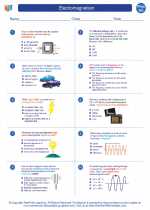Rotation in Physics
Rotation in physics refers to the motion of an object around an axis. This type of motion is different from linear motion, where an object moves in a straight line. Understanding rotation is important in many areas of physics, including mechanics, astronomy, and engineering.
Key Concepts in Rotation
When studying rotation, there are several key concepts to understand:
- Angular Displacement: This is the angle through which a point or line has been rotated in a specified sense about a specified axis.
- Angular Velocity: This is the rate of change of angular displacement with respect to time. It is measured in radians per second (rad/s).
- Angular Acceleration: This is the rate of change of angular velocity with respect to time. It is measured in radians per second squared (rad/s2).
- Moment of Inertia: This is a measure of an object's resistance to changes in its rotation speed. It depends on the distribution of mass around the axis of rotation.
- Torque: Torque is the measure of the force that can cause an object to rotate about an axis. It is the product of the force and the perpendicular distance from the axis of rotation to the line of action of the force.
- Rotational Kinetic Energy: This is the energy an object possesses due to its rotation. It depends on the moment of inertia and the angular velocity of the object.
Equations of Motion
Several important equations are used to describe the motion of objects undergoing rotation. Some of the key equations include:
Angular Displacement: Δθ = θf - θi
Angular Velocity: ω = Δθ / Δt
Angular Acceleration: α = Δω / Δt
Moment of Inertia: I = ∑mr2
Torque: τ = rFsin(θ)
Rotational Kinetic Energy: KErot = (1/2)Iω2
Study Guide for Rotation
When studying rotation in physics, it's important to grasp the following concepts:
- Understand the difference between linear and rotational motion.
- Be able to calculate angular displacement, velocity, and acceleration.
- Learn how to calculate the moment of inertia for different objects and understand its significance in rotational motion.
- Understand the concept of torque and how it relates to rotational motion.
- Be able to apply the equations of rotational motion to solve problems involving rotating objects.
- Understand the concept of rotational kinetic energy and how it is related to the motion of rotating objects.
Practice solving problems involving rotation to reinforce your understanding of the concepts and equations. Additionally, explore real-world examples of rotation in action, such as the motion of wheels, gears, and celestial bodies.
By mastering the concepts and equations related to rotation, you'll develop a strong foundation in rotational physics and be better prepared to tackle more advanced topics in the field.
[Rotation] Related Worksheets and Study Guides:
.◂Physics Worksheets and Study Guides High School. Electromagnetism

 Worksheet/Answer key
Worksheet/Answer key
 Worksheet/Answer key
Worksheet/Answer key
